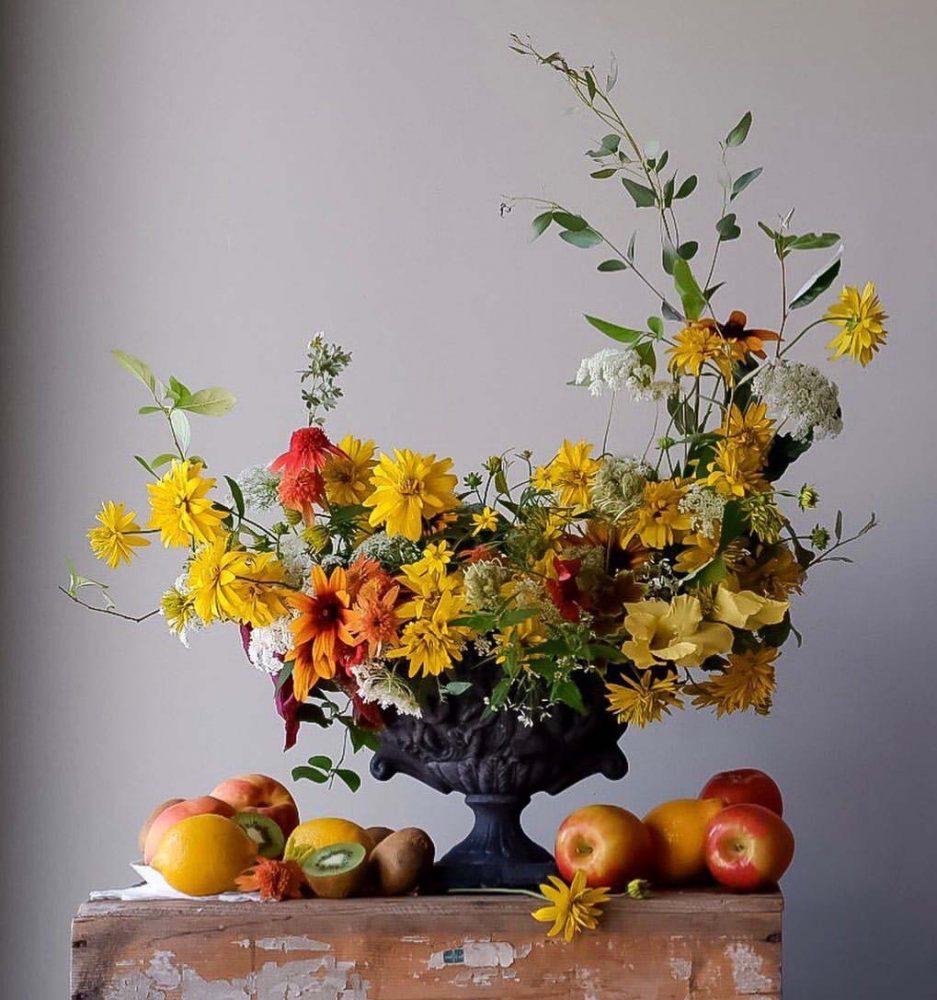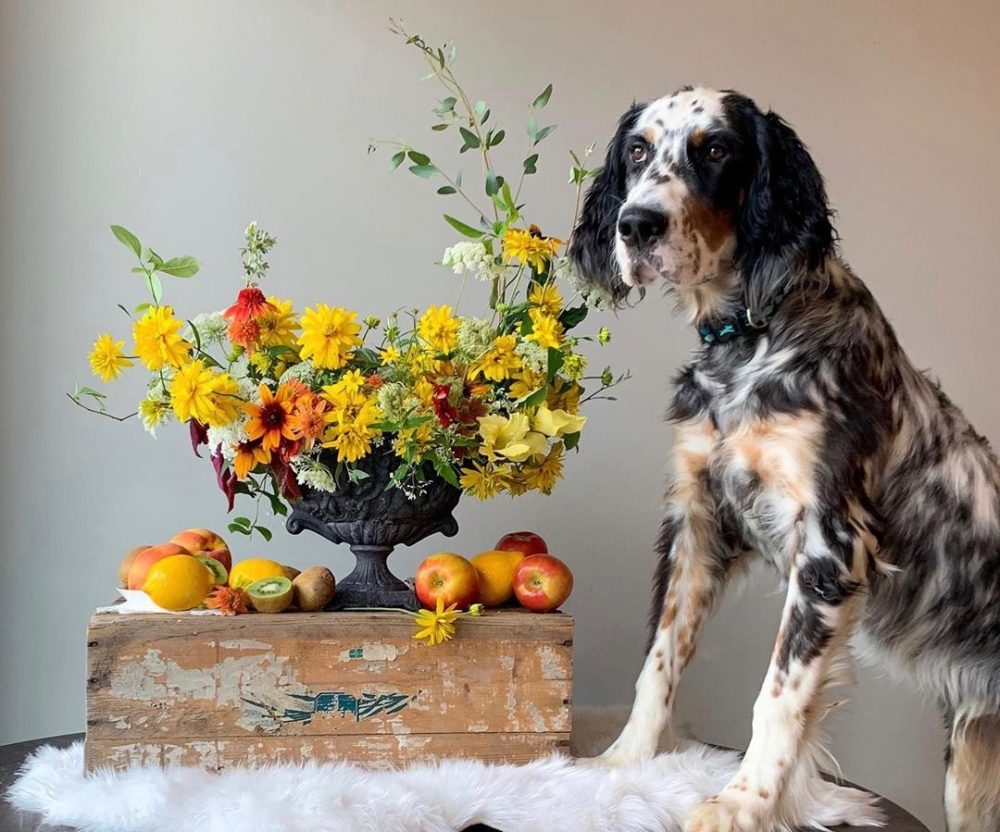
Materials
Flowers
- Rudbeckia – ‘Hortencia’
- Rudbeckia – ‘Campfire’
- Gaillardia – ‘Spintop Red’
- Echinacea – ‘Double Scoop Cranberry’
- Echinacea -‘Supreme Cantaloupe’
- Euphorbia – ‘Diamond Frost’
- Gladiola – pale yellow
- Queen Anne’s Lace (foraged)
- Coreopsis
- A few snips of potentilla
Foliage
- Itea – ‘Henry’s Garnet’
- Russian Olive (foraged)
- Geranium foliage
- Coleus
Mechanics
- Pin frog
- Chicken wire
Q&A
Flower magazine: When we wrote to ask you to do a Q&A about crescent arrangements, you responded that the shape is one of your favorites. Tell us why.
TJ McGrath: I see the crescent shape in nature all the time. I see it in the gentle downward curve of a redbud as it begins to leaf out after flowering and the weight of those heart-shaped leaves pull the branch down in a gentle curve toward the earth. I see it on the woodland floor in ferns and fallen branches while I’m walking my dog. I love that it’s a shape all around me in nature; not obvious, you have to look for it. Would it sound crazy if I said I love the challenge? That’s definitely one of the things I love about designing this shape. I think it challenges me both technically and creatively. Whether you’re setting it with your branches or blooms, sometimes you have to get pretty innovative with your product if it’s not naturally curving the way you want. I also love the challenge of achieving the shape in different vessel styles, whether round, oblong, or even square. I think mostly what I love about it is that, for me, it’s a very engaging and romantic shape; inviting the viewer to look more closely, and maybe even spark their imagination (it does for me anyway).

What are your favorite types of stems/branches to use to create the curves in this classic shape?
I love to use foraged branches as much as possible. I can’t stay that I have a go-to variety to begin when designing this shape; I look for an organic that possesses this shape naturally. For instance, early in the spring itea, forsythia, spirea, and plum are great foliage that sometimes all you have to do is study and turn its natural curve to create that upward arch of the crescent shape. As far as flowers, my favorites are tulips because you can manipulate their stems should you need to.
Can you talk about the role of negative space in the crescent shape? Where is the focal point?
Negative space is mostly important at the extremities of the shape itself. I believe it’s the negative space that creates movement and ultimately becomes the initial focal point even if the design is full of beautiful blooms that should be the rightful focal point. However, eventually, these blooms do get their due attention because the negative space brings the viewer’s eye from the top of the crescent, down, and through to the other side of the design.
Do you use crescent arrangements to frame other elements in a room/event, or do you prefer for the arrangement to stand alone, or both?
I wouldn’t say I design the arrangement to the space too specifically, or to frame a particular element or feature in the room. That’s not to say that I don’t think this shape can’t do that, just that it’s not present in my mind while I am designing. When I am designing, I imagine them as stand-alone pieces. Once delivered and set in place, if I have to edit for the piece to better suit the space, I’ll do that. At Blue Jasmine, we’re very fortunate to have clients who trust in our design, allowing us to create what we love, and then adjust in the space if need be.
When filling in the curve of the crescent, how do you know when enough is enough?
I don’t really have a “rule of thumb” that I follow regarding knowing when enough is enough. Sometimes enough is when you run out of flowers; however, lots of times I think is more is more. Who doesn’t love a lot of flowers, so is there ever really enough? What I can say is that I edit both during the design process and at the end when I think it’s finished. I think it’s the editing that allows me to achieve the shape, especially when I am using different type containers.
What mechanics do you use?
I almost always use a pin frog and chicken wire. I have tried using a tape grid, and you can do it, but I prefer chicken wire and a frog. I feel like they allow you more freedom while designing. Recently I have acquired a couple of vintage oblong/oval-shaped vases that have a bit more of narrow opening and the frog doesn’t really sit right in the basin, so I am working with just chicken wire as my structure and it’s challenging. I’m finding I have to be more fluid, fill in the bottom of the design with blooms and branches, and then as I have some more tension from those stems I can set the crescent with taller, longer curved organics. I have learned that without the frog, setting the extreme branches or negative space is best done towards the end of the design process, otherwise the branches just spin and fall over.
What type of containers work best?
I love a footed or pedestal-type vase, ideally with a basin that is a bit more shallow. I feel that those are the easiest type of vase to design in, but I think you’d be able to create the crescent shape in just about any vase.
Should novices be intimidated by the crescent shape?
Novices should never be intimidated by anything! I don’t think anybody, no matter what their level of experience is, should let intimidation keep them from trying something new. It’s only by pushing myself to do things that I haven’t done before, like trying shapes that were out of my comfort zone, that has enabled me to feel like I’ve grown as a designer.
Any other tips about crescent-shaped arrangements?
I think my best tip would be to go about a crescent shape both determined and accidentally. By “determined,” I mean to set out to make the shape using those curved branches to achieve that negative space. By “accidentally” I mean to pay attention to what the flowers are doing while you are designing, and if the flowers are indicating a particular shape, go with it and see where it takes you! I think that’s probably how I ended up with the first crescent-shaped arrangement I ever made and photographed. So, allow the process to unfold naturally.
Produced by Terri Robertson
